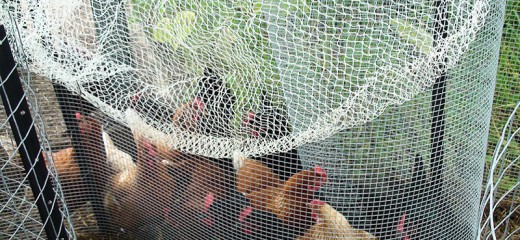
When we set out to build our chicken house there were a few core design elements that we considered as important for a design success. We wanted the ability to walk only a few steps to throw compost to the birds, collect eggs and to have them close enough that we can hear whats going on in case of threat. We have never had any issue with foxes being able to enter the chicken house or runs as we had an excavator dig around the outer perimeter to allow us to set the wire fence into the ground and bent slightly outwards. We then secured corrugated metal against the wire and staked it in tightly. With soil then replaced, we built a garden bed all around the runs and planted bamboo to form a thick set of roots to prevent digging.
The size of the house (4m x 5m x 3m) is certainly large enough for about 50 birds but we only run about 25 so that they have ample space to move around which we believe adds to their health and happiness. Originally we had Black Australorp and Isa Brown Chickens with more recent introductions of some White Leghorns. We had a couple of Wyandotte Birds which did ok and we tried Barnevelder but these were unsuccessful (Which we suspect was the breed rather than the environment)
There are a few interesting aspects to point out in the design. Firstly, the way that we have installed the egg laying boxes which has the chickens sitting on the inside of the house. This is the reverse of what is usually seen where the nesting boxes hang outside, however our theory is that to keep the birds warm and safe inside the house was a better idea.
Secondly is the design which is a deep litter system meaning that we keep about 1m thick dry grasses and hay inside the house which creates such a huge dry sponge that it soaks up any and all moisture that the birds create therefore staying fresh smelling.
Also noteworthy that the 4 runs we built which are 5m x 5m are designed as a multi purpose composting machine. Originally when we only had the egg laying birds we gave them the first quadrant and one other, leaving the other two to be planted out to food. The plan was to rotate
them every 4 months.
We also had 5 fruit trees in each of the 4 quadrants each encircled with wire to keep the chickens away from the roots. The trees were doing well until we experienced a few very wet years which turned the runs into a muddy mess about knee deep. To try and help with the moisture we installed a tarpaulin over the runs to give the birds some respite from the relentless weather. This removal of the sun however didn’t do any of the fruit trees any good however so we decided to relocate most of them to the food forest and about a year later we decided to take the cover off to again bring in the sun for the health of the birds.
To manage the water requirements for the birds we started using plastic watering dispensers. To fill them involved taking them out of the runs and filling each one manually then carrying them back inside and tying them up. As our bird population increased, this water management task became a real time issue and we finally designed and installed an automated bird watering system that provides for small cups with little plastic levers that, when pressed down, opens the valve to provide fresh water on demand. The free time that this automation provides along with the freshness of the water for the birds is a definite success.
We feed our chickens with a high quality layer mash of mixed grains and corn which is really just a supplement to the insects and greens that they forage around to find. They are also the lucky recipients of the daily kitchen compost (which is plentiful) that we take great pleasure from turning into eggs and rich compost.
In the past we have used multi bird feeders where the birds were able to simply eat as much as they liked. One thing we learned though was that by leaving food out overnight brought the rat population to the runs to enjoy eating food intended for the chickens. To manage this we decided to stop using the feeders rather opting to feed the birds in the morning by throwing the food around the runs. This saw a number of benefits including the fact that by nightfall, there was no food left in the runs therefore virtually eliminating the rat problem as well as providing a more natural scratching and eating behaviour from the chickens. The other result of this change was a decrease in the amount of food consumed and a healthier foraging energy being displayed by the birds when free ranging around the farm.
Once each year, we get a team together to dig out all of the compost and chicken manure from all four runs which is taken over to the composting bays to become part of a hot composting process.
We then clean out all of the hay from the chicken house into the runs (therefore replenishing them with lots of dry material. The chicken house is then thoroughly cleaned with a strong gurney and then refilled with fresh hay and grasses.
Regarding egg laying we find the nature of the egg laying is cyclical over the different seasons with egg production being between 12-36 eggs per day depending on a few variables including the season, weather, feed levels and age of the birds. We sell our eggs for $5.00 per dozen and all the reports from our customers are that they are really exceptional.